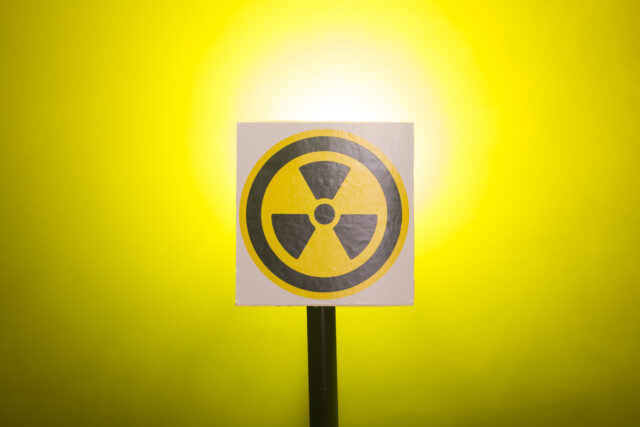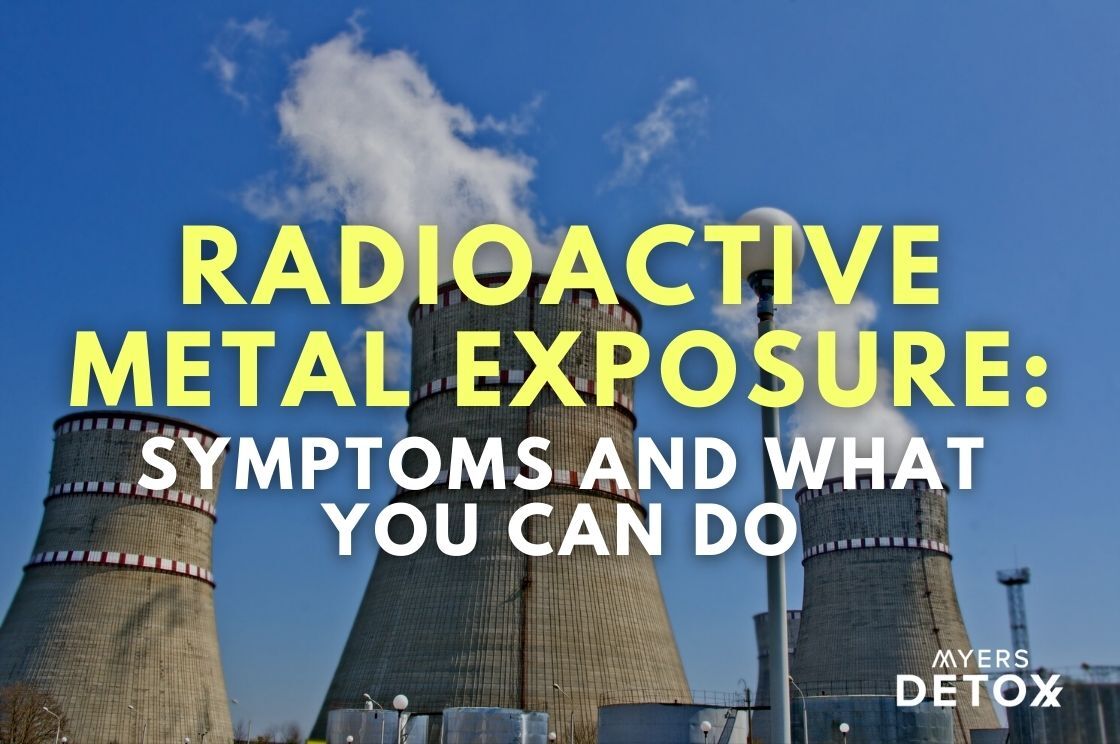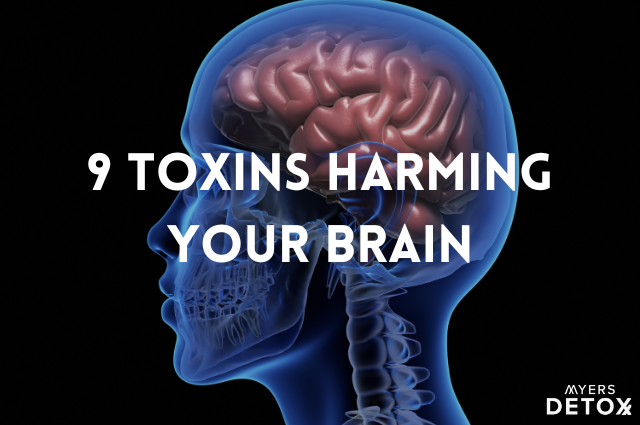Worried about radioactive metal exposure? Learn all about radioactive metals and what you can do in this article!
You’ve likely heard me talk in depth about heavy metals like mercury, lead, and toxic metals like aluminum. However, another class of toxic metals gets little press but is more damaging: radioactive metals.
If the word “radioactive” makes you think of nuclear bomb sites, then you’re on the right track…but these metals aren’t only found in areas where nuclear weapons have been released or there have been nuclear accidents (Fukushima in 2011 and Chernobyl in 1986).
Radioactive metals are everywhere in our environment and are incredibly damaging to the body and your DNA. You need to know about these metals.
In this article, we’re going to cover:
- What radioactive metals are
- How you’re being exposed to radioactive metals
- The threats that these toxic compounds cause to your health
- What you need to know about detoxing radioactive metals
What Are Radioactive Elements?
Radioactive elements contain a nucleus that’s unstable due to excess nuclear charge. Due to this instability, these elements are prone to decay, which results in radiation in the form of alpha, beta, or gamma rays.
Now, you’re probably familiar with the concept of radiation, as it’s used widely in the medical industry. But what’s the real story behind radioactive frequencies?
The danger with radiation comes from the elemental decay process. As a radioactive element begins to decay, it first splits into a “daughter” compound, which is still radioactive, and in the process, releases alpha radiation. Alpha radiation is the least harmful type of radiation as it can only travel short distances and it can’t penetrate the skin. That said, when alpha particles are inhaled, they can cause serious damage – more on that to come[1].
The next stage of decay involves the daughter once again splitting, except this time, beta radiation is released. Beta particles are able to penetrate through your skin, which begins the threats to your physiology.
And when that final daughter splits, it releases gamma radiation which not only penetrates your skin but can go all the way through your body and damage your DNA, which leads to a multitude of health issues, including cancer.
How You’re Exposed To Radioactive Metals

As mentioned, most people assume that radioactivity is something that people only need to worry about if they live near nuclear power plants or sights where nuclear weapons have been used – and this is simply not the case.
Radioactive elements are everywhere in our environment. In fact, there are trace amounts of naturally occurring radioactive compounds that have always been a part of the natural world. Unfortunately, today what was once only a “trace” is now becoming a serious problem. Let’s take a look at two common radioactive metals that you should know about:
Plutonium
Plutonium is considered primarily a man-made element, although it can be found occurring naturally in rare circumstances. Chemically speaking, plutonium is created when another element, uranium, absorbs an atomic particle. As such, most plutonium existing in the environment is the result of nuclear weapon testing and nuclear reactor accidents. This compound is also used in satellites as a power source.
Due to the microscopic nature of plutonium particles, they are dispersed widely in the environment. This means that you could be exposed to plutonium by breathing it in the air, through the water supply, or in the food you eat if it’s grown in contaminated soil.
The half-life of plutonium (which is the term used to describe the amount of time it takes for the intensity of a chemical to reduce by half), ranges from 87 to 6,500 years, depending on the form. This means that although nuclear testing was put to an end in 1980, there is still a significant amount of plutonium in our environment – and it will remain for many years to come[2].
Health Dangers of Plutonium
Since plutonium decays into alpha radiation, your risk for exposure comes primarily from inhalation and consumption.
When you breathe in plutonium, some of it may get trapped in your lungs, killing lung cells and resulting in respiratory disease. From here, plutonium particles are absorbed into your bloodstream, circulating throughout your body and depositing in your bones, liver, spleen, and kidneys[3].
Now here’s the real scary part; once plutonium enters your body, it stays there for a very long time – 30 to 50 years, to be exact[4].
Some health conditions and symptoms associated with plutonium include[2][5]:
- Lung cancer
- Inflammation and scarring in the lungs
- Kidney toxicity
- Bone toxicity
- Hair loss
- Nausea
- GI distress
- Skin burns
Radium
Radium is another radioactive element formed via the breakdown of uranium in the environment.
Radium was discovered about 100 years ago and quickly became a popular additive for consumer products, including toothpaste, hair creams, and some food products. Throughout the 20th century, radium was also widely used in the medical industry. Fortunately, scientists eventually discovered the adverse effects of radium, and beginning in 1970, its use in consumer products was banned. That said, there are a few applications for which radium is still used, including industrial radiography[6].
Furthermore, the half-life of radium is 1,600 years…so we’re certainly not in the clear when it comes to this toxic compound in our environment just yet[6].
Health Dangers of Radium
The EPA warns that chronic exposure to high levels of radium can result in an increased incidence of bone, liver, or breast cancer.
Moreover, as radium decays, it creates a radioactive gas called radon. Radon is a widespread contaminant of soil and can collect in homes and buildings by seeping into the building through the soil.
Radon is the second leading cause of lung cancer in the United States (second only to smoking), with the EPA estimating about 21,000 deaths per year from radon-induced lung cancer[7][8].
Radon is a colorless, odorless gas, so many people have no idea they’re being exposed to this deadly gas. Furthermore, since it comes from the soil and can seep into your home, it doesn’t matter if your home is old or new, well sealed or drafty, you’re still at risk for radon exposure. This is why it’s crucial to have a radon detector in your home to prevent exposure. Without the detector there is simply no way of knowing if your home is accumulating radon. If you have a radon detector in your home be sure to check the batteries every year.
Other Radioactive Metals To Be Aware Of
In addition to plutonium and radium, there are several other radioactive metals lurking in our environment. At one point these elements were considered “rare earth metals,” however, we’re seeing higher and higher levels of these elements in the environment today due to their industrial usage.
For example:
- Lanthanum is a radioactive metal found in water.
- Cerium is a radioactive metal that’s found in flint, used as a pigment, and found in flat screen TVs.
- Samarium is a radioactive metal used in recycling for plastics.
- Gadolinium is a radioactive metal that’s commonly used as a contrasting agent in MRIs and CT scans. It’s extremely difficult for the body to detox and its health effects can be devastating for many people that do not detox well. You can read more about Gadolinium toxicity.
- Dysprosium is a radioactive metal that’s used in electric cars and wind turbines
- Terbium is a radioactive metal used in low energy light bulbs.
- Iridium is a radioactive metal used in electrical contacts and fountain pens.
While you may be able to detoxify most heavy metals using chelating agents, these radioactive metals are too large for most chelators to remove. Furthermore, once these metals hit your body they catalyze a series of reactions that damage your body in various ways. Even if you’re able to remove the metal, the reactions that were catalyzed act as a secondary toxin that the body doesn’t know how to deal with.
This is why we need to take thoughtful action when it comes to removing radioactive metals from our bodies.
Your Best Bet For Helping Your Body Remove Radioactive Metals
Okay, so they’re everywhere in our environment and highly toxic. So what do we do about radioactive metals?
Interestingly, one of the most effective ways of removing radioactive compounds from your body is by drinking distilled water.
The water distillation process involves heating contaminated water until it forms steam, also known as a vapor. Any molecules that are heavier than the steam are left behind as the steam rises and separates from the rest of the water. This leaves behind microorganisms, non-organic compounds, and large organic molecules. Put simply; it separates out all the toxic debris you don’t want to be consuming.
Once the water has vaporized, that vapor is funneled into a condenser and removed from the heat source. As the vapor cools, it reverts to its liquid form, and what’s left is pure, unadulterated water[9][10].
I don’t recommend drinking distilled water for more than a couple months at a time. The water molecules in distilled water are “hungry”. Distilled water is great for removing metals, but it’s a weak method at best. Additionally, this hungry water can drastically deplete minerals. And most people are already low in minerals. But it’s useful in its ability to seek out and bind to heavy metals and radioactive metals.
In addition to distilled water, a metal chelator known as DOTA (dodecane tetraacetic acid) has the capacity to grab onto and help your body remove larger molecules like radioactive heavy metals. DOTA is basically a larger version of EDTA, which is a well-known chelating agent that works wonders for smaller molecules, but EDTA doesn’t have the capacity to bind radioactive metals due to their large molecular size.
Due to DOTA’s size and binding capacity, it can create stronger covalent bonds with radioactive metals, and thus effectively help to remove these toxic compounds from your body.
Takeaway
Radioactive substances are everywhere in our environment, in the air, soil and water. These particles have half-lives of thousands of years, and more is being released into the environment every day because they are still being used today in many applications and released into the environment from nuclear testing and accidents.
There have been many nuclear accidents and I’m sure many that we don’t know about. For instance, Fukushima is still releasing radioactive substances into our environment over a decade later. This information is largely ignored and swept under the rug, but the release of radioactive metals into our environment is a threat to our health that cannot be ignored.
Luckily, a few simple solutions exist. If you’re already drinking filtered water, I suggest you step your game up and drink distilled water maybe a couple months out of the year. But be sure to replete minerals while you’re drinking distilled water and afterward a detox session with distilled water.
Distilled water can help your body remove these radioactive metals, but its not going to be nearly as effective as a metal chelator. If you want to do a heavy duty detox of radioactive metals, I suggest an appropriate chelator like DOTA.
*These statements have not been reviewed by the FDA. The information herein is not intended to diagnose, treat, cure, or prevent any disease. Nor is it meant to replace or act as a substitute for speaking to a medical doctor and/or licensed health practitioner. Any products discussed are not intended to diagnose, treat, cure, or prevent any disease. They are not intended to replace any medication, medical test(s), or healing modality prescribed by your medical doctor. Please consult with your doctor before beginning a new supplement regimen.









